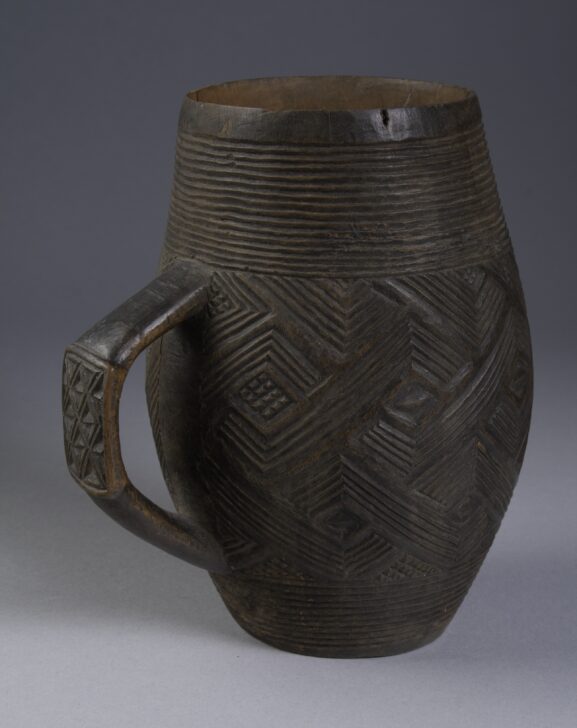Cup
Kuba

Description
Subject Matter:
Kuba artists apply their bold and sophisticated surface designs to both ceremonial and everyday objects alike. Objects such as drums, boxes, stools, backrests, knives, swords, bangles, wisdom baskets, staffs and fly whisks were typically reserved for the king and his courtiers. However, these objects in addition to cups, rubbing oracles, pipes, combs, drinking horns, ritual spoons, and scepters also served specific religious and ceremonial functions, or were simply everyday objects for common use. Whether they were related to prestige, used as divination objects to protect the community or simply served as conversation pieces for decoration, the commonality these objects often share are the elaborate geometric patterning and lavish surface design.
Often times ornately designed cups were created as a form of competition among title members. The cups were additionally used to drink palm wine. Palm wine, made from raffia palm trees was a popular beverage among Kuba men and women. Elaborately decorated cups were generally reserved for ceremonial purposes.
The geometric patterns on this cup are similar to patterns found on Kuba textile, basketry, sculpture, and female body scarifications. Patterns may be given names, but the same pattern will likely be given a different name by different people. The diamond pattern on this cup is created through a crossing and interlocking of chevrons. A double crossing can possibly be considered a reference to Woot, the mythical founder of the Kuba, whose mother invented mat weaving.
Daniel Biebuyck, The Arts of Zaire, 1985
Georges Meurant, African Textiles from the Kingdom of Kuba, 1986
Roy Sieber, African Textiles and Decorative Arts, 1972
Jan Vansina, The Children of Woot, 1978
Physical Description:
Vertically positioned cup with a slight bulge in the middle. Trapezoid shaped handle with intersecting linear design on it. The top and base of the cup are carved with multiple horizontal lines and in between are interlocking chevrons.
Usage Rights:
If you are interested in using an image for a publication, please visit https://umma.umich.edu/request-image/ for more information and to fill out the online Image Rights and Reproductions Request Form.